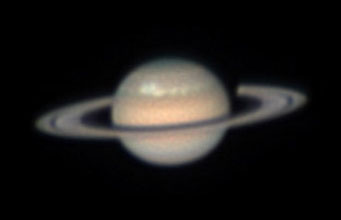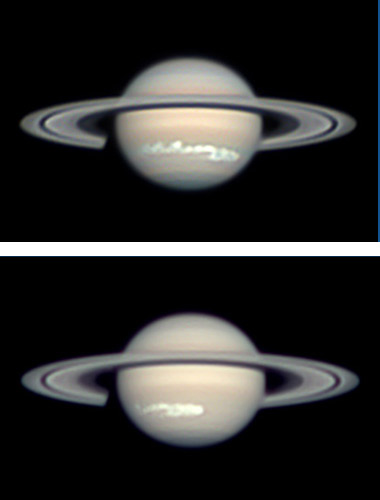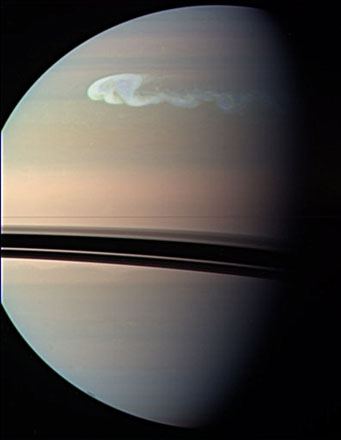
A view of Saturn's dramatic storm, as recorded on December 25, 2010, with a 12½-inch reflector and an Imaging Source CCD camera. North is up.
S&T: Sean Walker
The two largest planets in our solar system are now putting on an exciting show for observers — and they're perfectly placed for those of you hoping to try out that new telescope or eyepiece holiday gift.
On Jupiter, the revival of the South Equatorial Belt has spread to almost completely encircle the planet. Jupiter is a snap to find blazing high in the south at nightfall.
Meanwhile, a new white storm has burst forth on Saturn. Perhaps the ringed planet was feeling neglected due the attention heaped on Jupiter recently.

If you haven't been watching Saturn before dawn, get out there! By January 2nd its huge white outbreak had spread far around the planet and was easily visible in amateur telescopes when it's facing Earth — though not so vividly as in these extraordinary images. Don Parker in Florida shot them with a 16-inch reflector and a Luminera Skynyx II-0 camera on the morning of January 2, 2010, at 10:09 and 11:30 UT. "On these images the storm extends from 267° to 325° [System III longitude]," he writes. Here, south is up.
Donald C. Parker
First spotted by amateurs Sadegh Ghomizadeh and Teruaki Kumamori on December 8th and 9th, Saturn's storm spans more than 100° of longitude as of January 5th, in the North Tropical Zone (roughly 34° north). The bright "head," or leading edge, was originally located at System II longitude 157° (293° in System III).
Saturn is now well up in the southeastern sky before dawn, far to the upper right of bright Venus. Be on the lookout for rapid changes to the feature's shape and extent. Here are transit-time predictions of the original outbreak site through January 13th (in Easterm Standard Time, which is UT minus 5 hours).
This disturbance is not the same one noted by amateurs earlier this year, which appeared at a dynamic southern latitude band nicknamed "Storm Alley."

The Cassini spacecraft took this dramatic snapshot of the ongoing storm in Saturn's northern hemisphere on December 24, 2010. North is up. Click here for a larger view.
NASA / JPL / Space Science Inst.
Veteran planet-watcher Thomas Dobbins notes the last time such a large storm appeared on Saturn was 1994, but that one had much lower contrast with its surroundings than the current event. This disturbance is easily the brightest feature on the globe — it even rivals the brightness of the planet's ring system.
NASA's Cassini spacecraft has a "ringside" seat for the roiling clouds, as seen in the shot at right, which was taken on December 24th and transmitted to Earth on the 27th. Check the mission's website for other high-resolution images of the planet.
Click here to see a gallery of recent storm images.
 4
4









Comments
dennis sherald
March 18, 2011 at 5:52 pm
wow...
You must be logged in to post a comment.
Ea
April 1, 2011 at 12:39 pm
This could be huge collection of clouds.
You must be logged in to post a comment.
Ea
April 1, 2011 at 12:43 pm
This ccould be a collection of cloud.
You must be logged in to post a comment.
Navneeth
August 27, 2011 at 12:28 pm
Why did this article come up in my RSS feed on 27 Aug, 2011?
You must be logged in to post a comment.
You must be logged in to post a comment.